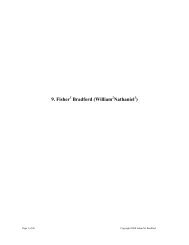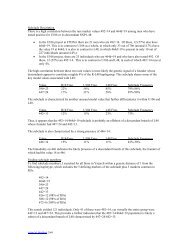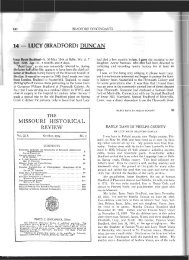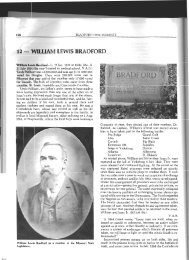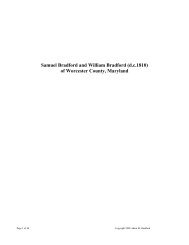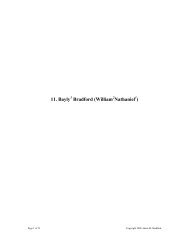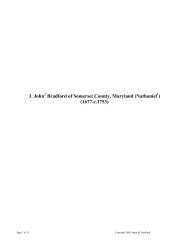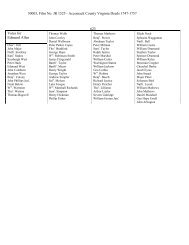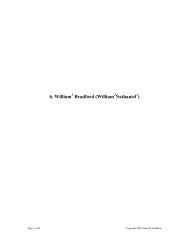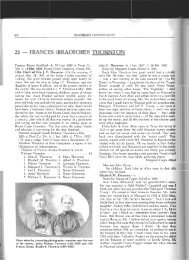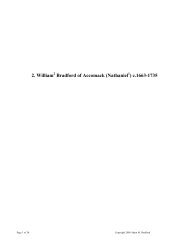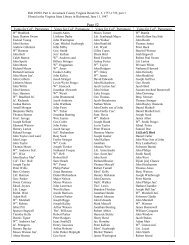1. Nathaniel Bradford of Accomack County, Virginia - Lower ...
1. Nathaniel Bradford of Accomack County, Virginia - Lower ...
1. Nathaniel Bradford of Accomack County, Virginia - Lower ...
You also want an ePaper? Increase the reach of your titles
YUMPU automatically turns print PDFs into web optimized ePapers that Google loves.
The fundamental division within the Court came to a head in June <strong>of</strong> 1653. In that month, one <strong>of</strong> the<br />
Justices, Captain Thomas Johnson, a partner <strong>of</strong> Scarburgh’s in his 1651 raid, went so far as to assemble<br />
many <strong>of</strong> the shore’s inhabitants in Dr. George Hacke’s field, where he publicly read orders <strong>of</strong> the <strong>County</strong><br />
Court which he found distasteful and incited the people gathered there to oppose them. Justice Stephen<br />
Horsey, like Stephen Charlton a signer <strong>of</strong> the Northampton Protest, added to the public tumult by calling<br />
his fellow Justices a “company <strong>of</strong> asses and villyanes”. Sensing their authority in jeopardy, the Court<br />
applied for help from Governor Bennett and the assembly at James City, representing the agitation <strong>of</strong><br />
Johnson, Horsey, Scarburgh and others in a seditious light. In response, the Assembly ordered the<br />
subscribers <strong>of</strong> the Northampton Protest to be removed from <strong>of</strong>fice and dealt out the same treatment to<br />
Colonel Scarburgh, who was commonly known to have been a prime mover behind the Protest, though not<br />
a signer. On 29 July 1653, the governor, having personally come to Northampton <strong>County</strong>, held a court <strong>of</strong><br />
investigation which fined several Justices <strong>of</strong> Northampton for words and deeds deemed harmful to the<br />
authority <strong>of</strong> <strong>Virginia</strong>’s Parliamentary Commisioners. Before the Governor’s arrival on the shore, an order<br />
had also been issued calling for the arrest <strong>of</strong> Colonel Scarburgh for conspiring to sell arms to the Indians,<br />
since he was rumored to have a substantial stock <strong>of</strong> weaponry in one <strong>of</strong> his ships that happened to be<br />
engaged in trade with them. Before the Governor’s arrival Scarburgh fled <strong>Virginia</strong>, making arrangements<br />
for the disposition <strong>of</strong> his estate among his children should he be unable to return.<br />
Scarburgh Ascendant, The Restoration <strong>of</strong> the Monarchy, Formation <strong>of</strong> <strong>Accomack</strong> <strong>County</strong><br />
The year 1653 saw the nadir <strong>of</strong> the fortunes <strong>of</strong> Scarburgh’s political faction: its leaders either deprived <strong>of</strong><br />
power or forced to flee the colony, their desire for action against the Dutch and the Indians thwarted, and<br />
their political influence crushed by the residence <strong>of</strong> the governor on the shore for nearly a full year.<br />
Afterwards their fortunes rebounded. By 1656, both Argoll Yeardley and <strong>Nathaniel</strong> Littleton had died,<br />
leaving Colonel Obedience Robins as the lone holdout <strong>of</strong> stature in the Court against those in Colonel<br />
Scarburgh’s camp. By then, Scarburgh had managed to become cleared <strong>of</strong> the allegations against him, and<br />
his position was restored. In 1659, he gained authority from the Assembly at Jamestown for an expedition<br />
against the Assateagues just across the Northampton border in Maryland in retaliation for certain<br />
depredations committed upon the Marylanders. In that year, Scarburgh was himself a member <strong>of</strong> the<br />
Assembly, and he no doubt used his influence there to secure the authority to proceed against the<br />
Assateagues. Since we find <strong>Nathaniel</strong> <strong>Bradford</strong> so frequently associated with Scarburgh, and since we<br />
know <strong>Nathaniel</strong> was later a horseman in the county militia, it’s natural to wonder whether he may have<br />
taken part in this raid against the Assateagues, though the names <strong>of</strong> the participants are not recorded.<br />
In 1660, Charles II was proclaimed the rightful King <strong>of</strong> England, putting an end to<br />
over a decade <strong>of</strong> rule by Parliament under the Commonwealth and by Oliver<br />
Cromwell during his Protectorate. In the summer <strong>of</strong> that year the erstwhile<br />
governor, William Berkeley, was rewarded by Charles II for his loyalty to the<br />
crown and reinstated as governor <strong>of</strong> <strong>Virginia</strong>. Two years later, Scarburgh’s old<br />
rival Obedience Robins passed away. The year after that, Scarburgh and his<br />
associates were able to secure at long last a project they had worked towards for<br />
over a decade: the division <strong>of</strong> the eastern shore into two counties. In 1663<br />
<strong>Accomack</strong> <strong>County</strong> was created from Northampton <strong>County</strong>, giving “King<br />
Scarburgh”, as many <strong>of</strong> his neighbors referred to him, his very own kingdom. 75<br />
Birth <strong>of</strong> William <strong>Bradford</strong><br />
By the time <strong>of</strong> the formation <strong>of</strong> <strong>Accomack</strong> <strong>County</strong> out <strong>of</strong> Northampton <strong>County</strong>, <strong>Nathaniel</strong> <strong>Bradford</strong> had<br />
purchased, even if he wasn’t already seated on, his plantation at Matchapungo. It was around this time,<br />
specifically around 1662 or 1663, that <strong>Nathaniel</strong>’s second son William was born. 76<br />
* * * * *<br />
<strong>Nathaniel</strong>’s Jury Service<br />
In the first year <strong>of</strong> <strong>Accomack</strong> <strong>County</strong>’s existence <strong>Nathaniel</strong> appeared frequently in court as a juror, mostly<br />
in cases involving stolen, killed or injured livestock. Cattle and pigs in 17 th century <strong>Virginia</strong> were generally<br />
Page 19 <strong>of</strong> 74 Copyright 2008 Adam M. <strong>Bradford</strong>




